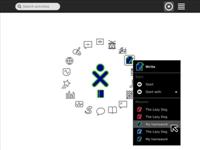While reading one of the hundreds of e-mails related to OLPC that I’ve been finding in my inbox these past few days I realized something: When we’re talking about “Sugar” everyone seems to have a different idea of just what it is. Obviously the lack of a clear understanding of “Sugar” make every discussion about it that much harder.
There are several different perceptions of what “Sugar” is or at least should be. The three most popular ones seem to be:
(1) Sugar is the User Interface. It’s all about the UI and how information is presented to the user. It’s also a tailored UI in that it’s very much adapted to the target user group, children, instead of the jack-of-all-trades software solutions that we’re used to.
(2) Sugar is really the technology developed for OLPC. It’s the underlying services used on the XO such as collaboration, the presence service, the data store and so on.
(3) Sugar is the overall user experience on the XO. It’s been argued that Sugar really is the combination of both the UI and the underlying technologies and that separating one entity from the other would break the whole concept.
Here is my (slightly philosophical) take on the situation: Sugar is a “gravitational force” when it comes to developing software, content and services for educational purposes.
Allow me to elaborate. During an interview with Apple’s Steve Jobs in October 2004 BusinessWeek asked him the following question:
“What can we learn from Apple's struggle to innovate during the decade before you returned in 1997?”
Steve Jobs replied:
“… Lots of companies have tons of great engineers and smart people. But ultimately, there needs to be some gravitational force that pulls it all together. Otherwise, you can get great pieces of technology all floating around the universe. But it doesn't add up to much. … There were bits and pieces of interesting things floating around, but not that gravitational pull.”
To me Sugar is that gravitational pull. None of the technologies and concepts embodied in Sugar are fundamentally new. What’s new is the unique combination of a very different approach to key aspects of computing: the desktop metaphor, information storage and retrieval (Journal) and the fact that collaboration is a “first order experience” (as Walter Bender put it). It’s this combination that makes Sugar unique and sets it apart from much of the other available software solutions.
Sugar is currently very much focused on providing a platform for laptop-based educational purposes but I can see the principals embodied in Sugar working on a variety of different devices, in different applications and for different services. In the short-term I imagine Sugar becoming available for community-based internet-cafés, computer-labs in schools and similar scenarios that are relatively closely connected to the mission at hand. I believe that services will follow suit, for example educational platforms such as Moodle being tailored to fit into an XO and school-server based environment.
Taking it a step further it’s not that hard to envision “Sugar” coming to a device near you from the much-discussed computing cloud, basically being a Web-based service that you can use from any connected device at your disposal. In that sense it reminds me of Microsoft’s slogan when it announced its HailStorm initiative many moons ago:
“Any time, any place and on any device.”
To conclude, we can spend a lot of time discussing what Sugar is or should be, whether the technology running in the background should be decoupled from the UI or if it should be ported to Windows and OS X. The fact remains that Sugar is a strong gravitational pull for an innovative approach when it comes to presenting information on connected computing devices. To me Sugar is also a good example of Alan Kay’s famous quote:
“The best way to predict the future is to invent it.”




Cris:
I agree with you that sugar is a centralized idea, that ties everything together. That's what attracted me to it from the beggining, the ideas on it.
But the problem is that the idea is not the reality, and while sugar is still a bright concept, it's already what's powering real users on the real world. And what people judge, what they see, is the experience they have in the real world.
I believe in sugar, the idea, but it needs an incredible amount of work to be translated into real user experience that will attract users, developers and sde projects in this "gravitational pull".
One of my favorite examples now is the iPhone UI. Is totally different from what a normal computer is, but yet because it's simple, people grab it and run with it. Blogging was a great new idea in content managing, way better than files, and people ran with it. We are used to find new UIs in every new web service we learn, yet sugar, as it is, is a challenge for many adults.
I believe in sugar, but we have a lot of work to do, because the time were we could defend it on the basis of what it could and can be theoretically is over. Sugar must be a reality.
I am a fan of the OLPC project but developing Sugar was a waste of time. It is not really innovative and lacks a lot of necessities (active tasks should be on the border, activities cannot be grouped ...etc)
Believe me, a tuned Xfce would have been fine for the children. And OLPC could have concentrated on really important issues like power management.
XFce and other UIs for Linux are windowed presentations. Every window open is using precious memory. The Sugar UI does not use chunks of memory to display windowed applications and is therefore less resource hungry.
What we see in the Sugar UI is a full screen application or 'activity' that makes maximum use of a small screen and only pops up the system menu around the border when the cursor moves to the edge (or corners) or the screen. This is the basic groundbreaking concept and moves away from the 'windowed' concept.
How information is displayed in the border menus has constantly evolved over time and is being refined. Truly a great 'small screen' UI that uses minimum resources.
What does slow down the XO are other non optimized applications that have been written by lazy programmers.
Robert, as a programmer myself, I don't buy this full-screen-apps-save-memory idea. The 1984 Macintosh--vastly less powerful than the XO--was windowed. Non-optimized apps written by "lazy" programmers can slow down a system, but don't be too harsh with coders: optimization is hard work. I know, I just spent three months optimizing a program for a mobile platform. Coders run their program on their own PCs and they run fine... they don't even know there's a problem with running it on the XO unless they personally try running it on the XO.
Running htop will show anyone who cares to look into things and not just spout about them that the problem is not "other non optimized applications that have been written by lazy programmers." It problem is sugar. Period.